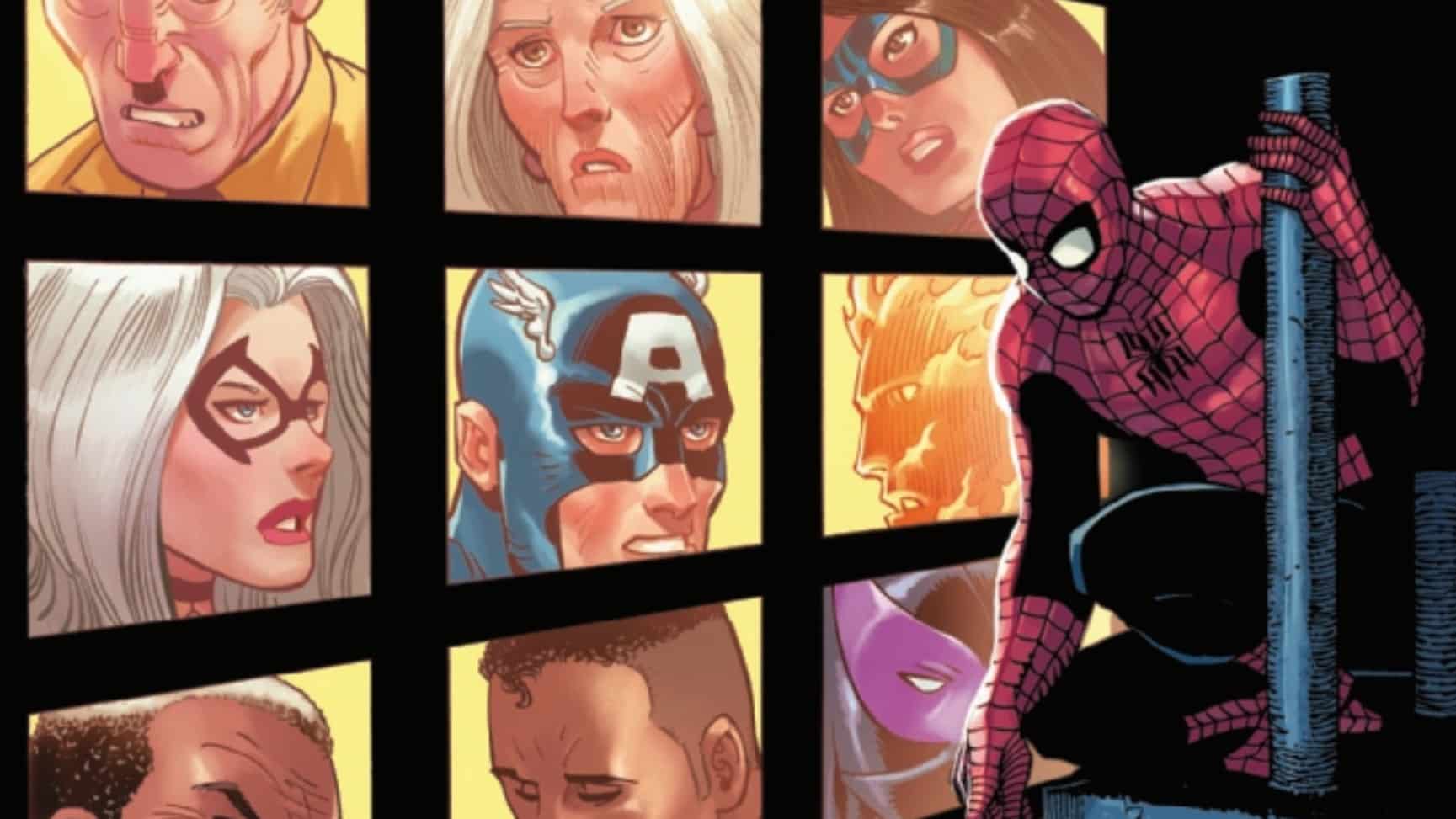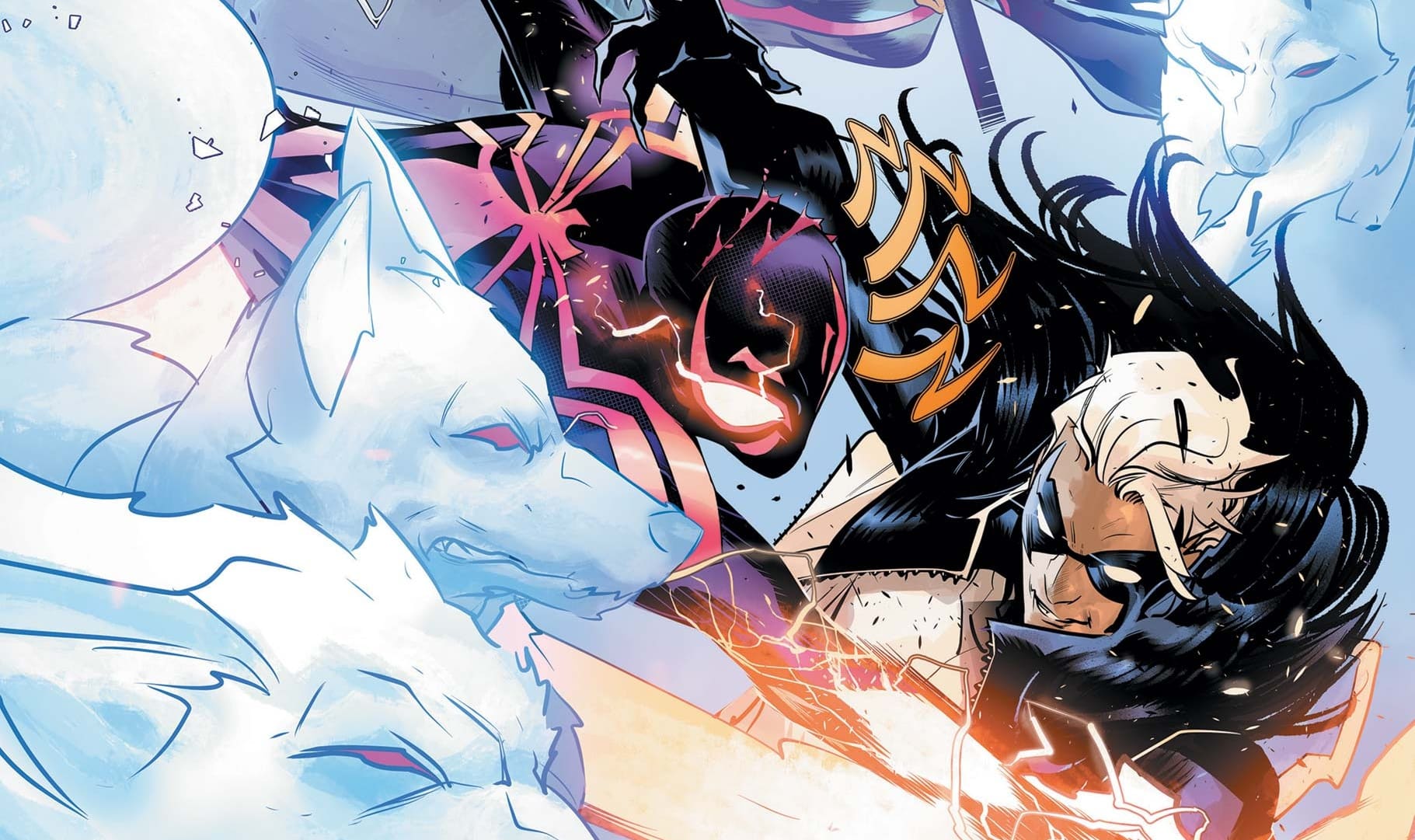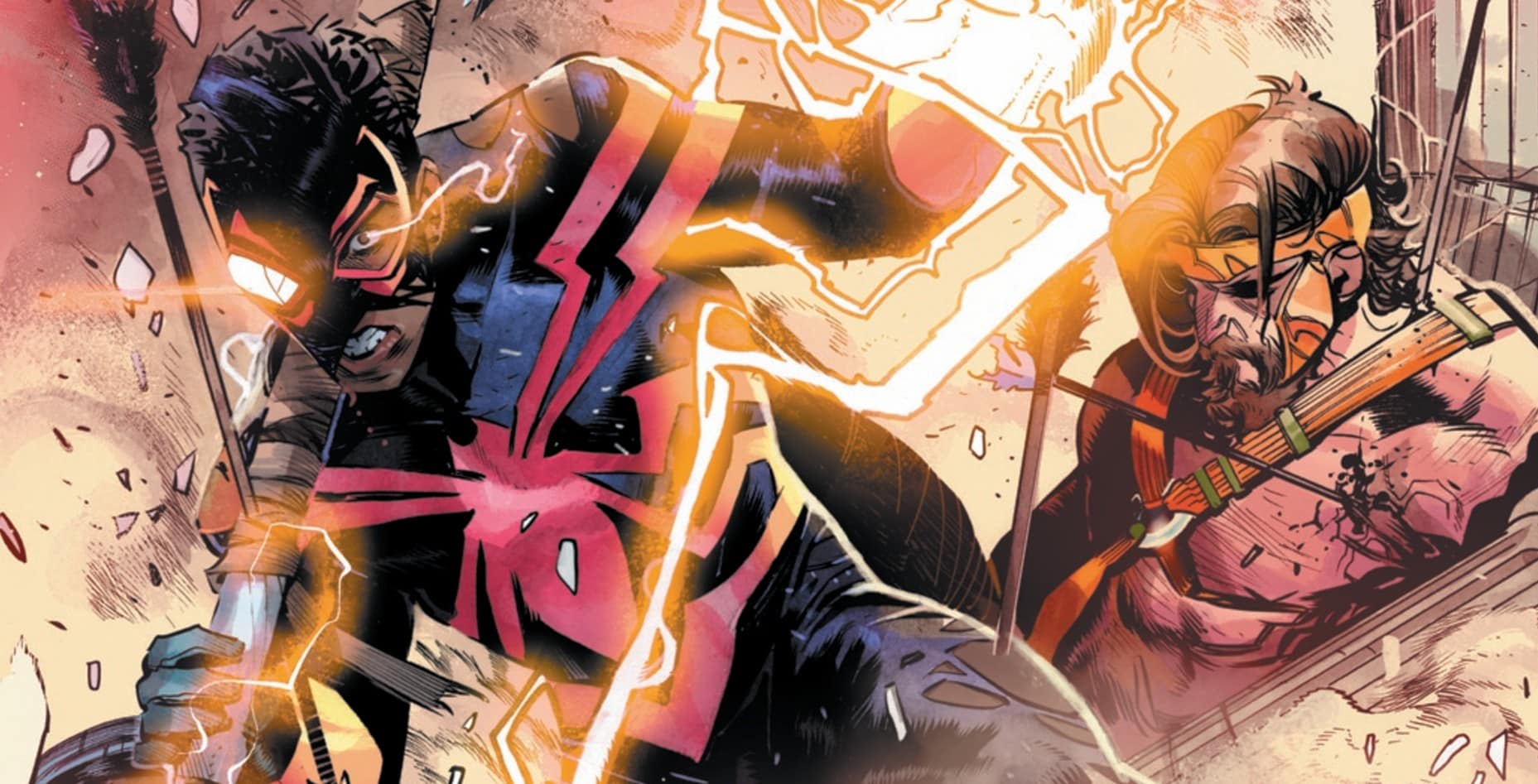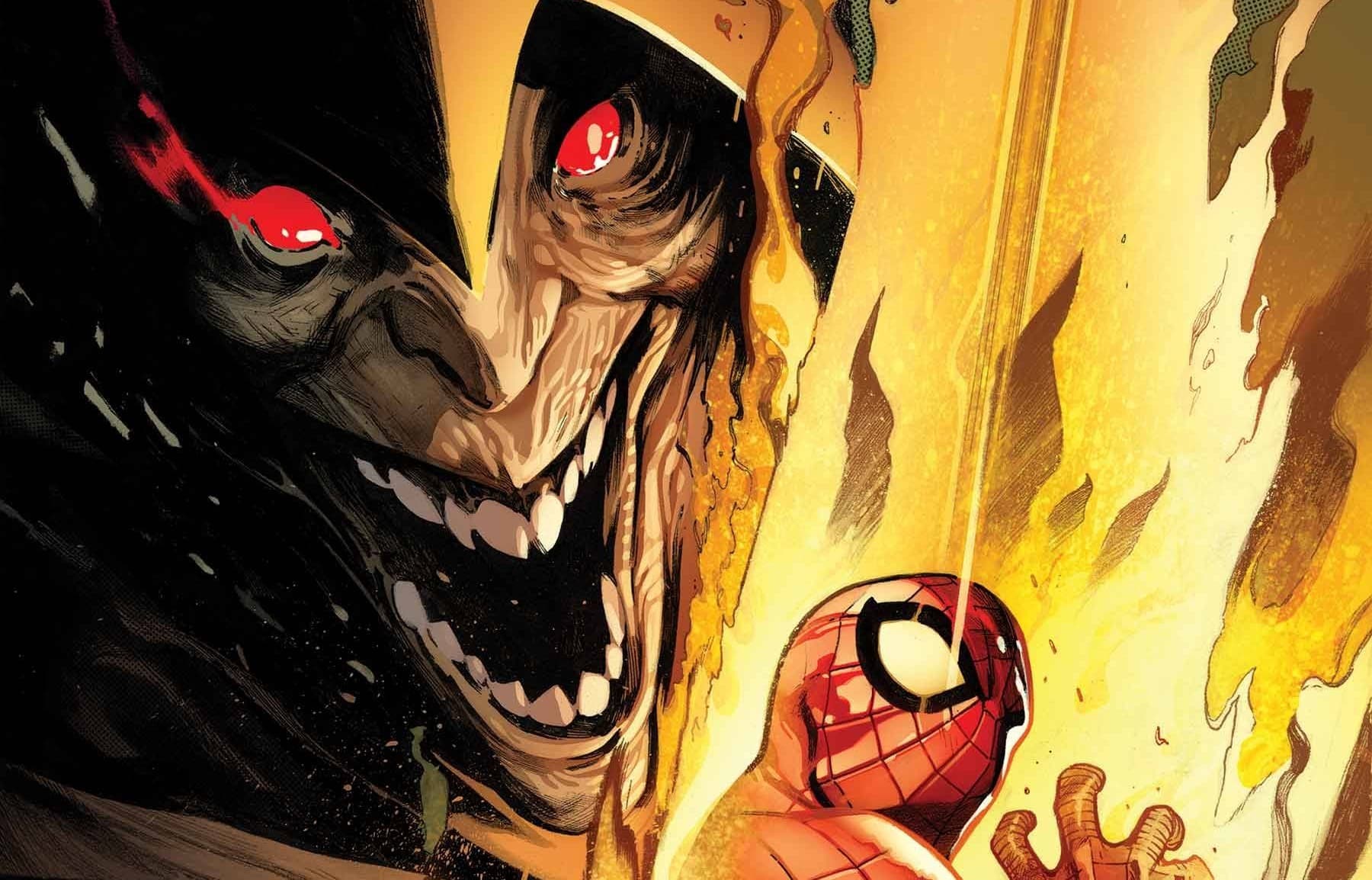The Emissary of a death god crosses dimensions for a ritual sacrifice to gain ultimate power. Chaos erupts — and a hero dies. Amazing Spider-Man #26 is written by Zeb Wells, penciled by John Romita Jr., inked by Scott Hanna, colored by Marcio Menyz and Erick Arciniega, and lettered by Joe Caramagna.
Tony Thornley: It’s been a little over a year since I last wrote about Amazing Spider-Man Vol. 37 (not actual volume number) for ComicsXF. In that time a lot has changed about the series. But the big moment has finally come and … well, there’s no way that I can possibly talk about it alone, so this week Armaan Babu and I are taking a look at the biggest Marvel moment of the summer.
Comics and online casinos are two distinct forms of entertainment, but there are a few potential commonalities:
Entertainment Value:
Both comics and online casinos aim to provide entertainment. Comics offer engaging visual storytelling through illustrations and narratives, while luckytigerslots.com online casino offer games and the excitement of gambling.
Digital Accessibility:
Both comics and lincoln-casino.org are increasingly accessible in digital formats. Digital comics and online casino games can be accessed through various devices such as smartphones, tablets, and computers.
Visual Appeal:
Comics and online casino games often rely on visual elements to capture the audience’s attention. Comics use illustrations to tell a story, while online casino games use graphics and animations to create an immersive gaming experience.
Variety of Themes:
Both mediums offer a wide variety of themes to cater to diverse audiences. Comics can explore genres ranging from superhero adventures to romance, and online casinos feature games with themes like fantasy, adventure, sports, and more.
Engagement and Interaction:
Both comics and online casinos aim to engage their audience. While comics engage through visual storytelling and narrative, online casinos engage players through interactive gameplay, bonuses, and challenges.
Community Engagement:
Both comics and online casinos can foster a sense of community among enthusiasts. Readers discuss and share their thoughts on comics, and online casinos often have communities where players can share experiences and strategies.
Storytelling Element:
Some online slot games within casinos incorporate storytelling elements into their gameplay. These games may have characters, plotlines, and thematic elements similar to those found in comics.
It’s important to note that while there are some potential commonalities, these two forms of entertainment serve different purposes and cater to distinct audiences. Comics are a storytelling medium, while online casinos primarily focus on gaming and chance. Individuals engaging in these activities should do so responsibly and in a manner that aligns with their preferences and values.
Yeah, we’re calling it. And it’s not at all for good reasons.
Armaan, I wish I could say that it’s a pleasure as always to chat, but this one is less than fun. Kamala Khan has died. And honestly, there’s a lot of bad about that fact completely out of context, but I think it’s made even worse by the fact that it’s just not a good issue. I’d even go as far as saying it’s bad.
Armaan Babu: The decision to have it happen in the first place is terrible. I don’t think we could put across how bad that choice is more clearly than Adrienne Resha does over at WWAC, but to sum up: As a bizarre celebration of the anniversary of The Night Gwen Stacy Died, Spider-Man #26 doesn’t just fridge a woman in Spider-Man’s life, but a teenage, Pakistani Muslim, right during Asian American and Pacific Islander Heritage Month.
I’m not going to say exactly that I was hoping they would do this story well; it shouldn’t have happened in the first place.
But I didn’t expect it to be this deserving-of-italics bad.
Let’s dive into what makes it so.

Tony: One point before we do — it’s not just that she’s a female, teenage Pakistani Muslim. She’s the only female, teenage Pakistani Muslim superhero in comics. And this is a book by a predominantly white male creative team. But we’ll get to that in a minute.
So I have issues with this story right off the bat. Kamala was introduced as a supporting character in this volume fairly early on. That would be great if she was actually a supporting character, and not just a series of glorified cameos. I don’t think she even really teamed up with Peter for more than a page before this issue.
This opening scene just feels like trying to rectify that problem a bit. I feel like it makes it worse, though. Kamala interviewing at OsCorp is awkward and backward-looking in a way that should have been done months ago, and Romita’s Kamala is so off model. If it wasn’t for Menyz’s colors, she would have looked like any of Romita’s women. The dialogue is awkward. It’s just not good.
Armaan: I imprinted on John Romita Jr.’s art in the J. Michael Straczynski run of Amazing Spider-Man. His art is not for everyone; there’s an ugliness to his style that doesn’t sit well with everyone. It’s an ugliness I enjoy — the world as drawn by him is grimy and gross while making room for being silly. No one draws Spider-Man being pushed to the edge of his limits quite like JRJR.
In this run, however, his artwork is … cleaner. But not all the way. It’s trapped in this horrible limbo of not playing to JRJR’s strengths while not achieving a more typical Marvel House style either. The worst of both worlds. And his Kamala Khan is … unrecognizable. Especially in the interview scene — I don’t know who that’s supposed to be, but that is not Kamala Khan.
Tony: I think this run has been the strongest Romita’s art has looked since probably World War Hulk or his Avengers run with Brian Michael Bendis — which I think inker Scott Hanna deserves credit for as much as Romita. This opening scene though just shows a weakness that Romita has always had. Everyone ends up looking like a New York Italian American or a generic white person. For someone like Kamala, whose culture and background is so important to their identity, that’s so incredibly glaring.
Armaan: I’m not going to lie, I was really excited to have her included in this book. I’m a big fan of the character, and it’s a shame that it’s been so long since she’s had her own series. Still, I’ll take what I can get, since I’m a pretty big fan of Spider-Man as well. I was looking forward to these two meeting up — to Peter Parker and Kamala Khan spending time together, and Spider-Man and Ms. Marvel doing the same.
Since her creation nearly a decade ago, the two have had very little interaction on the page, despite being two characters who I believe would be delightful together. Both bright, earnest superheroes who I believe represent some of the best Marvel has to offer. Don’t get me wrong, I’m glad she’s spent so much time hanging with Miles Morales, but aside from a truly delightful, underrated story in Marvel Team-Up, I’ve been holding my breath for the kind of interaction that this series promised, and grossly underdelivered.
Tony: Yes, absolutely. There’ve been fewer than 10 (maybe even fewer than five) team-ups between Peter and Kamala, and most of them have been delightful. But her Spider-relationship is with Miles, who frankly is her best costumed friend. His absence in this issue given that relationship’s importance is actually kind of glaring, even though Miles has barely appeared in this series.
Armaan: For those who haven’t been keeping up with the series, Kamala’s barely had more than the odd cameo in the book every few issues or so. I frankly forgot she was in the book until Dark Web gave her a little more of a spotlight — during which time she was still kept far, far from the main action of the event.
So yes, her sudden spotlight in this issue feels about as shoehorned in as it could possibly be, and for the very worst of reasons — a rapid, abrupt lead-up to her death.
Tony: And let’s be real, it’s glaringly obvious where it’s going. Kamala is the co-lead of Marvel’s biggest movie release of the year. There’s not a chance in hell she’s going to be dead come November. This is a plot device being used to set up another plot device that’s going to support a larger corporate product. And that’s exactly what fridging is — a plot device. A bad and overused plot device that disproportionately affects female characters. It’s moved beyond trope and cliche into a crutch. At this point, we need to get past the over-reliance on it.
You and I said this pre-gaming this conversation: This just makes me mad.

Armaan: It baffles me who Marvel thinks this is for. Fans of Ms. Marvel, wanting to see more of her, have to be confused as to why she’s been such a small part of the book only to be pulled out at the last minute in a rushed lead-up to her death.
Fans of Spider-Man who haven’t been following Ms. Marvel have to be confused as to why this random, barely mentioned teenager is pulled out at the last minute in a rushed lead-up to her death.
What possible person could this story impact? Which fans, exactly, is this story meant to satisfy? Aside from the outrage of how bad a decision it is (and hey, we have plenty of that), to whom can this story possibly matter?
Tony: I’m going to go back to what I said: It’s glaringly obvious to whom it matters — corporate synergy. The WWAC piece you linked said it more delicately. This is setting up an origin retcon, and this is the most heavy-handed and poorly executed way they could do it.
Armaan: I think what adds insult to injury is how poor the main story is here, the one that led to all of this. This all started in January 2022, when Marvel gave us a teaser for Spider-Man’s new relaunch with the question: “What Did Peter Do?” The comics jumped six months ahead, with a whole new status quo for Peter’s life. He’s somehow on the outs with the Fantastic Four, he’s working with Norman Osborn, and instead of being in a happy relationship with Mary-Jane Watson, we discover she’s married, with children, barely even willing to hold a civil conversation with the man who, last we saw, she was deeply in love with.
Now, the Mary Jane/Peter relationship has been jerked around a lot, in astoundingly convoluted ways. There have been deals with the devil. Octopus-themed villains possessing Peter’s body. Clones, symbiotes, stalkers — I don’t think there has ever been a reason these two have been broken apart that remotely resembles anything normal, and besides being exhausting … it’s uninteresting.
I feel it’s fair to say that one of the biggest appeals of Spider-Man as a character is how grounded Peter Parker is. Peter worries about bills, about making time for the loved ones in his life, about trying to find a way to keep going when the world throws everything at him whether or not his mask is on. His relationship troubles with Mary Jane, however, have been anything but grounded. It’s all comic-book convolution at its worst. How is anyone meant to care? To connect to these characters, and care about their story? Where, in all this tumultuousness, is the human at the heart of these stories that made Spider-Man so popular in the first place?
Zeb Wells was on thin ice with this new relaunch — and now that we’ve finally found out why Peter and Mary Jane broke up this time, it’s not just more of the same. It’s worse.
Shall we talk about the whole Paul situation, and the strange extradimensional god stuff this comic desperately wants us to believe matters?
Tony: Yes, but let me respond to the first part of what you said.
The mystery box is a problem at Marvel. Like I said about fridging a minute ago, it’s moved beyond trope and into a crutch. I think we recently counted five different series in the past year and a half that started with completely different mystery boxes. In my opinion only one of them has answered the mystery box in a satisfying way (Fantastic Four), and that’s because they answered all the questions by issue #5.
Armaan: I also think it was cleverly done — it satisfied the questions of what happened, why it happened, how it changed the status quo and most importantly, the changes inspired by it led directly into more interesting stories for the Fantastic Four. All without any doubts that all the people involved were acting in character.
Tony: Yes, exactly!
This trope only works when it’s either answered quickly or the answers are heavily foreshadowed. The only foreshadowing here was that something happened, and the something was clearly supernatural in a way that breaks the fiction. This was a mystery that had no clues, aka the worst kind of mystery.
But yes, let’s go back to Paul and the kids.
THEY AREN’T EVEN REAL. The kids are literally erased, and Paul is the son of the big bad (revealed in a nonsequitur flashback page) who was raised entirely in the alternate dimension, so he might not be real himself. Armaan! What the actual hell?
Armaan: Now, this is a minor quibble in the midst of a story that has much bigger problems, but it is strange just how much this story mirrors one of Marvel’s other infamously bad reveals: the story of the Scarlet Witch’s children, and how they were never truly real either.
Both stories feature characters of scarlet prominence, whose husbands don’t quite fit into the world and whose marriages are controversial among their peers. Both with powers revolving around probability whose upper limits are never defined. Most egregiously, both characters thrust suddenly into motherhood, whose storylines pivot around that, only for those children’s very existence to be revealed to be a cruel illusion crafted by a demonic entity as a means of furthering his own power.
Tony: I mean, we were talking a lot about Kamala being fridged, and let’s be real, the kids, while less important overall, are being fridged, too. And let’s talk about another part of this: There is story value to these main characters growing up. Frankly, since we have Miles around to be the younger, single, more relatable Spider-Man, there’s no reason why Peter and MJ can’t be married with 2.5 kids. Hell, look at Jody Houser’s run on Amazing Spider-Man: Renew Your Vows. Perfect example.
Comics writers need to be able to write about families that aren’t the Richardses or Wests in realistic ways. I am sick and tired of comics kids being erased, kidnapped, aged up and retconned away. Do I want these particular kids to stick around? No. Neither of them were developed in any way for them to be anything but what they are. I wasn’t attached to them. But the idea that a family can’t be a part of a story is just so tired at this point. Every other form of media is able to tell stories about families. Why can’t comics?
Armaan: I’m with you 100% there. Hey, when’s the last time we checked in with Aunt May? I miss that lady.
Tony: I think it was in Slott’s Spider-Man. I don’t remember the last present day interaction with her in this series (She was in the flashbacks in the last couple issues).
Armaan: We talked about how Ms. Marvel’s death felt shoehorned in. This whole Wayep/Rabin/Emissary thing feels equally shoehorned. This extradimensional villain has no buildup. No connection to any of the established lore in Spider-Man. He’s not connected to Spider-Man in any way, or Peter Parker, and both Rabin and Wayep’s motivations are as bland as one can imagine. A god of death wants … more people dead. His Emissary wants power. There is nothing that sets them apart as villains. Not character design, not dialogue, not their motivations — this entire arc is a forgettable footnote in the story that killed Ms. Marvel. A story she was barely part of, serving a decision that never should have been made in the first place.

Tony: Oh yeah. Rabin was a one-off villain from “Brand New Day” that was only memorable because the story was entirely about Wells and Chris Bachalo playing with the form of comics.
This feels like it should be a bigger deal. It’s treated like a threat on the level of several godlike beings from JMS’ Amazing run. It’s like Morlun or Shathra was at the time. Wells never is able to elevate it to that level. Not even the damn snake monster — which is disturbingly too Central American for a story with literally no ties to Central America in any way on the page or behind the scenes — feels like anything more than “something for the Thing to punch after the F4 forgives Peter.”
And let’s talk about how narratively unsatisfying that is. It only exists to draw the Four and Norman away from Peter and Kamala protecting MJ, and that’s not even executed well. I mean when the Four show up to the fight, Johnny Storm says “we’re coming in hot” and Ben Grimm yells “and orange!”
WHAT WRITER IN THE WORLD OPTS FOR THAT LINE OVER “IT’S CLOBBERIN’ TIME!”
I’m sorry, that’s not the main focus of this conversation, but it’s a good example of how this issue fails at even the most fundamental level.
Going back to the main issue at hand, this issue has simply failed, and I’m frustrated at the fact that this is not the first time THIS YEAR that the Spider-Man line has killed a major female character exclusively to push forward Peter Parker’s story and motivations. And yes, those characters killed were obviously going to be brought back quickly, just like I’m positive that Kamala will be in some form before The Marvels hits the big screen. It’s a systemic problem within this editorial group, and that’s incredibly damning for this story.
Armaan: Marvel introduced a mystery to us. A time skip, and a major change in the status quo. What that is is a challenge to themselves. The challenge is to justify the changes; to convince us that the new status quo makes for better stories, and that the mystery of how this happened is narratively satisfying.
The Amazing Spider-Man has failed on both counts. Nothing in the past 22 issues has proven that Peter’s new status quo makes for better Spider-Man stories. And nothing about how it all happened is a story that’s worth it. This comic has justified nothing, least of all the death of Kamala Khan.
There is speculation that this is a stunt; a way to bring Ms. Marvel back as a mutant, with new powers, and more in line with her television version. I’ve written about why that’s a terrible idea, too.
To say that Spider-Man fans deserve better storytelling is true, but unimportant. There are going to be Spider-Man comics for as long as there’s Marvel. Every new issue throws something at the wall, and some of it is going to stick. There have been great Spider-Man stories before, and there will be again.
To say that fans of Kamala Khan deserve better is an understatement. Her debut arguably captured people’s hearts in ways few heroes have since, well, Spider-Man. Ms. Marvel was a bigger success than anyone expected, and it wasn’t sensationalism that drew everyone’s eye. To see her death used like this, so cheaply, so lazily, in a story so rushed and so very impossible to care about, is disgusting.
That the people who decide what stories she gets to be a part of think that this was the best use of the character. That they’re so lacking in imagination, and in the fundamental aspects of storytelling, that this happened in one of its biggest comics, teased and talked about like it’s something worth being excited about, and executed so poorly.
Despite how much time we spend reading and writing about them, it’s an uncomfortable truth that Big Two comics are, far more often than not, mediocre reading. Crammed with convoluted, sensationalist pushes desperate to catch a dwindling audience’s attention on the strength of how the story is talked about instead of how good the story and the storytelling themselves are. There comes a point where the only way you can remain a fan is by embracing that pervasive mediocrity, to lower the bar and find a chuckle where you can in the midst of all the pretty colors.
Amazing Spider-Man #26, however, is bad. The bar was on the floor, and somehow Marvel dug themselves in even deeper — and they presented it with a grin on their faces, proud of what they accomplished.
I’ll give them this: I’m certainly amazed.
Tony: Couldn’t say it better myself.







